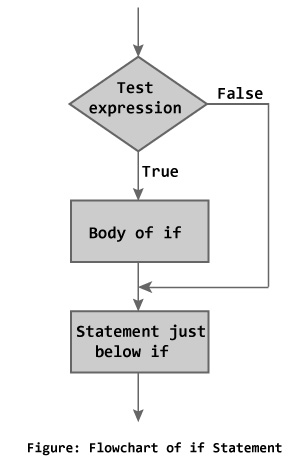Artikel Terkait Tutorial C
The
Selain Sebagai Penyedia Panduan Belajar Database dan Tutorial Pemrograman, Kami Juga Membagikan Kumpulan Source Code Program Aplikasi dan Ebook Pemrograman Terlengkap yang Bisa Anda Dapatkan Secara Gratis di Halaman :
if, if...else and nested if...else statement are used to make one-time decisions in C++ Programming, that is, to execute some code/s and ignore some code/s depending upon the test condition. Without decision making, the program runs in similar way every time. Decision making is an important feature of every programming language using C++ programming. Before you learn decision making, you should have basic understanding of relational operators.1. C++ if Statement
The
if statement checks whether the test condition is true or not. If the test condition is true, it executes the code/s inside the body of if statement. But it the test condition is false, it skips the code/s inside the body of if statement. Working of if Statement
The
if keyword is followed by test condition inside parenthesis ( ). If the test condition is true, the codes inside curly bracket is executed but if test condition is false, the codes inside curly bracket { } is skipped and control of program goes just below the body of if as shown in figure above. Flowchart of if
Example 1: C++ if Statement
C++ Program to print integer entered by user only if that number is positive.
#include <iostream>
using namespace std;
int main() {
int number;
cout<< "Enter an integer: ";
cin>> number;
if ( number > 0) { // Checking whether an integer is positive or not.
cout << "You entered a positive integer: "<<number<<endl;
}
cout<<"This statement is always executed because it's outside if statement.";
return 0;
}Output 1
Enter an integer: 5
You entered a positive number: 5
This statement is always executed because it's outside if statement.Output 2
Enter a number: -5
This statement is always executed because it's outside if statement.2. C++ if...else
Theif...else executes body of if when the test expression is true and executes the body of else if test expression is false.Working of if...else Statement
The if statement checks whether the test expression is true or not. If the test condition is true, it executes the code/s inside the body of if statement. But it the test condition is false, it executes the code/s inside the body ofelse.Flowchart of if...else
Example 2: C++ if...else Statement
C++ Program to check whether integer entered by user is positive or negative (Considering 0 as positive)
#include <iostream>
using namespace std;
int main() {
int number;
cout<< "Enter an integer: ";
cin>> number;
if ( number >= 0) {
cout << "You entered a positive integer: "<<number<<endl;
}
else {
cout<<"You entered a negative integer: "<<number<<endl;
}
cout<<"This statement is always executed because it's outside if...else statement.";
return 0;
}Output
Enter an integer: -4
You entered a negative integer: -4
This statement is always executed because it's outside if...else statement.3. C++ Nested if...else
Nested if...else are used if there are more than one test expression.Syntax of Nested if...else
if (test expression1){
statement/s to be executed if test expression1 is true;
}
else if(test expression2) {
statement/s to be executed if test expression1 is false and 2 is true;
}
else if (test expression 3) {
statement/s to be executed if text expression1 and 2 are false and 3 is true;
}
.
.
.
else {
statements to be executed if all test expressions are false;
}The nested if...else statement has more than one test expression. If the first test expression is true, it executes the code inside the braces{ } just below it. But if the first test expression is false, it checks the second test expression. If the second test expression is true, if executes the code inside the braces{ } just below it. This process continues. If all the test expression are false, code/s inside else is executed and the control of program jumps below the nested if...elseExample 3: C++ Nested if...else Statement
C++ Program to check whether the integer entered by user is positive, negative or zero.
#include <iostream>
using namespace std;
int main() {
int number;
cout<< "Enter an integer: ";
cin>> number;
if ( number > 0) {
cout << "You entered a positive integer: "<<number<<endl;
}
else if (number < 0){
cout<<"You entered a negative integer: "<<number<<endl;
}
else {
cout<<"You entered 0."<<endl;
}
cout<<"This statement is always executed because it's outside nested if..else statement.";
return 0;
}Output
Enter an integer: 0
You entered 0.
This statement is always executed because it's outside nested if..else statement.Conditional/Ternary Operator ?
Conditional operators are the peculiar case ofif...else statement in C++ Programming. Consider this if..else statement:if ( a < b ) {
a = b;
}
else {
a = -b;
}The above code can be written using conditional operator as:a = (a < b) ? b : -b;Both codes above check whether a is less than b or not. If a is less than b, value of b is assigned to a if not, -b is assigned to a.Selain Sebagai Penyedia Panduan Belajar Database dan Tutorial Pemrograman, Kami Juga Membagikan Kumpulan Source Code Program Aplikasi dan Ebook Pemrograman Terlengkap yang Bisa Anda Dapatkan Secara Gratis di Halaman :
Rekomendasi Web Hosting
- 20rb perbulan. Diskon hingga 40% kode kupon: MCP Daftar disini (apache).
- 10rb perbulan. Diskon hingga 75% kode kupon: MCP Daftar disini (litespeed).
- 10rb perbulan. Diskon hingga 70% kode kupon: aff-MCP Daftar disini (apache).




